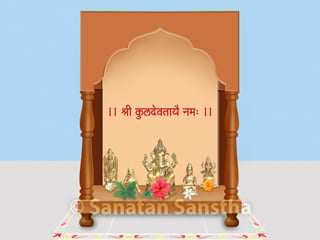Tulsi is a sacred plant. It has been mentioned in Skandapuran that some of the drops of nectar fell on the earth during the process of Samudramanthan (churning of ocean). Tulsi was formed out of them. It was handed over to Shri Vishnu by Shri Bramha. Tulsi is liked by Shri Vishnu and hence it is specially offered to Shri Vishnu. While citing the importance of Tulsi it has been mentioned in Padmapuran that offering flowers made of gold, stones and pearls do not have even one sixteenth of the importance of Tulsi ! Sins of even many eras are destroyed by sight, touch, meditation, obeisance, planting and use of Tulsi. Tulsi leaves used while offering naivedya to God. All deities reside in the plant of Tulsi from its roots to the tip. It constantly emits the principles of deities and makes the surrounding environment sacred. That is why a house with a tulasivrundavan is considered sacred.

- The unmanifest and subtle most Vishnu principle is absorbed through the stem of Tulsi leaf and is then converted into Krushna principle and goes on flowing through the stem.
- Chaitanya is activated at the base of the Tulsi leaf and is projected into atmosphere in the form of circles. This chaitanya simultaneously flows through the vessels of Tulsi leaf.
- The particles of Shakti (divine energy) are also present in the leaves of Tulsi.
- The particles of chaitanya and Krushna principle are transmitted into atmosphere through the inflorescence.
Tulsi plant – Symbol of vairagya (Detachment)
A tulsi plant symbolises detachment. Once when performing the ritual of tula (Weighing with food grain, gems etc.) of Shrikrushna, despite placing diamonds, precious stones, gold etc. in one pan, the other pan with Shrikrushna seated on it just did not move. Finally, only after a tulsi leaf was placed on all the wealth by Rukmini did the weighing scale balance. Through this incident, Shrikrushna taught that He could be won over only with detachment and not with wealth. Hence, phrases like ‘Placing tulsi leaves on the house’ depicts sacrificing the house.
Now our readers must have realized the spiritual benefit of offering Tulsi leaves to a deity during puja ritual. The effect of plucking such sacred Tulsi leaves has been described thus in Skandapuran, तुलसीं ये विचिन्वन्ति धन्यास्ते करपल्लवा: ।- Tulsi ye vichinvanti dhanyaste karapallavaaha’ means blessed are those hands who pluck tulsi leaves for the puja. Thus by knowing the importance of gathering the tulsi leaves for puja our faith in tulsi must have been enhanced to a great extent.
1. Why are the leaves of the Tulsi always pure ?
The Holy basil originally has 50% Vishnu Principle. When they it is used in the ritualistic worship the Divine Principle in them increases by 20%. The raja-tama in the environment affects every object. The enhanced 20% Divine Principle is used in combating the raja-tama in the atmosphere. The grossly apparent effect of this is that the Holy basil leaves appear dried up or singed. Nonetheless they continue emitting the Divine Principle originally present in them. Hence, the Holy basil leaves are always pure.
2. Why are tulsi leaves used while offering naivedya to a deity ?
We often see that while offering naivedya (food offering) to a deity it is offered with the help of two leaves of tulsi. One of them is kept on the naivedya while other is offered to the deity. Let us now understand as to why tulsi leaves are used while offering naivedya to God.
Tulsi has the greater capacity to absorb and emit sattvik and Krushnatattva frequencies present in the universe. Therefore use of tulsi while offering naivedya imparts two benefits.
- The tulsi leaf used while offering naivedya absorbs the subtle frequencies emitted from the food. When this tulsi leaf is offered to the deity, the deity principle rapidly absorbs the frequencies present in the leaf.
- There is subtle covering of raja-tama present in the atmosphere around the food to be offered to the deity as naivedya. When a tulsi leaf is kept on the food, the sattvik frequencies emitted from the tulsi leaf reduces this covering. Besides the atmosphere around the plate or banana leaf meant for serving the naivedya gets purified. This retains the sattvikta of naivedya for a long period.
Thus the tulsi leaf is used for offering naivedya for receiving the grace of the deity by pleasing Him/Her. Therefore there is a rich tradition of offering prayerful obeisance to tulsi plant loved by Shri Vishnu every morning and evening as mark of gratitude because it is a destroyer of negative energies and a purifier of the atmosphere.
3. Precautions to be taken while gathering Tulsi leaves
- Do not pluck the leaves singly, pluck them in pairs
- Pluck the tip of tulsi consisting of leaves without shaking the plant.
- When a manjiri (inflorescence ) is plucked then it should contain leaves.
If we pluck the tulsi leaves while simultaneously chanting the name of our favourite deity and with utmost respect and with proper method, the spiritual benefit received through the puja ritual multiplies a million times.
4. Why are women prohibited from gathering tulsi leaves ?
As specified in Dharma texts, women have a high proportion of raja component when compared to men. There is generation of heat energy in the dormant and serene sattvik frequencies present in the tulsi plant by the touch of women which leads to decrease in its sattvikta (sattva quality). Hence they are prohibited from gathering or plucking the tulsi leaves.
Reference: Sanatan Sanstha’s Holy Text ‘What is the importance of the substances used in Ritualistic worship?’


 How to perform Puja Vidhi ?
How to perform Puja Vidhi ? Importance of Puja Samagri in ritualistic worship
Importance of Puja Samagri in ritualistic worship How to arrange the substances in Puja Thali ?
How to arrange the substances in Puja Thali ? How should be the design of Devghar ?
How should be the design of Devghar ? How to arrange the Puja items used in puja ?
How to arrange the Puja items used in puja ? How to arrange Deities in Home temple ?
How to arrange Deities in Home temple ?
tulsi puja mahtev on